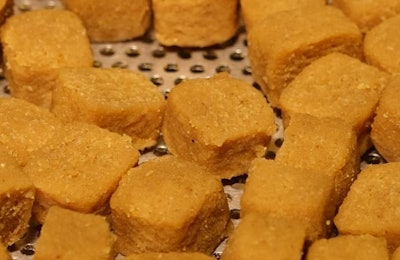
Extrusion remains an important process in the production of pet foods, including dog kibble and cat treats. Certain factors influence the production process, and pet food manufacturers can learn from research and previous reports on extrusion about how to maximize important factors, such as costs, safety, new product innovation and efficiency.
Why fiber in dog food increases extrusion energy costs
In an experiment, pet food extrusion energy use increased when insoluble fiber was added to dog food recipes, and this should be considered in the overall product price along with raw materials costs, said Aulus Carciofi, PhD, veterinary science researcher at Sao Paulo State University in Brazil.
In Carciofi’s experiment dog food formulated with wheat bran, sugarcane fiber and guava fiber all increased dough’s resistance to flow, which increased electricity use by a single-screw extruder machine. The results of the experiment were published in Animal Feed Science and Technology.
Considering the results of his research, pet food product developers and formulators may find it important to study certain pet food extrusion processing parameters, he said. Specifically, the mass moisture (in barrel moisture) and thermal energy application are important.
Pet food extrusion safety and innovation
In 2014, Petfood Industry explored regulations and consumer trends were driving safety and innovation in pet food extrusion.
One manufacturer, Coperion addressed food safety concerns through ease of machinery cleaning. In one of Coperion’s designs, intermeshing, self-wiping screws prevented stagnant zones along the whole length of the processing section of the extruder, which results in self-cleaning.
Beyond the specific focus of pet food safety, innovation drove extrusion, drying and cooling technologies. Along with improvements to existing technologies, extruder manufacturers attempted to meet the challenge of consumers’ demands for high-meat and grain-free pet foods.
2014 petfood industry extrusion round-up
Every year brings unique challenges to the extrusion segment of the petfood industry, and 2014 has been no different. Two key factors, brought on by significant industry events, are foremost on expert minds as the year closes: petfood safety and innovation.

















